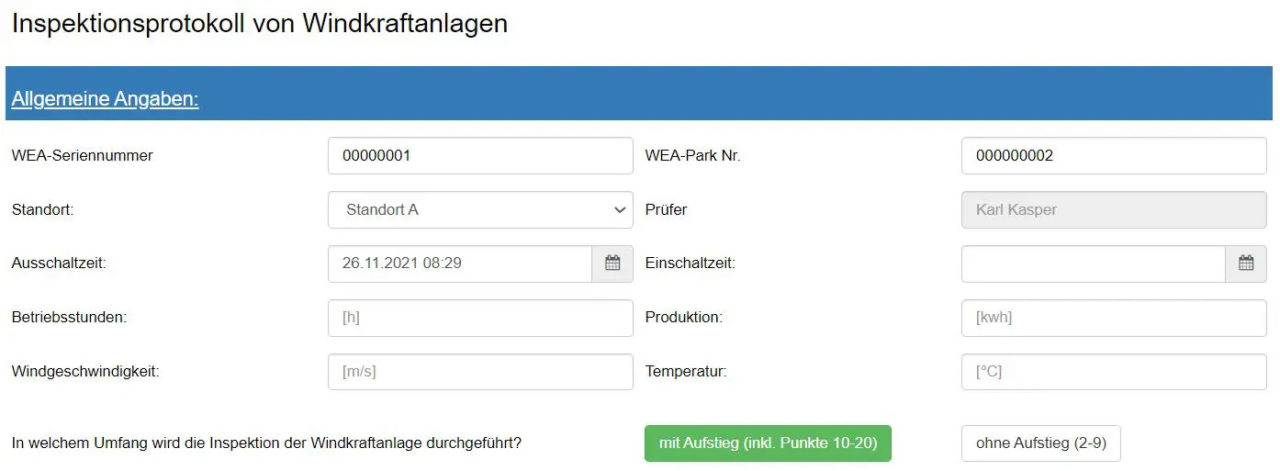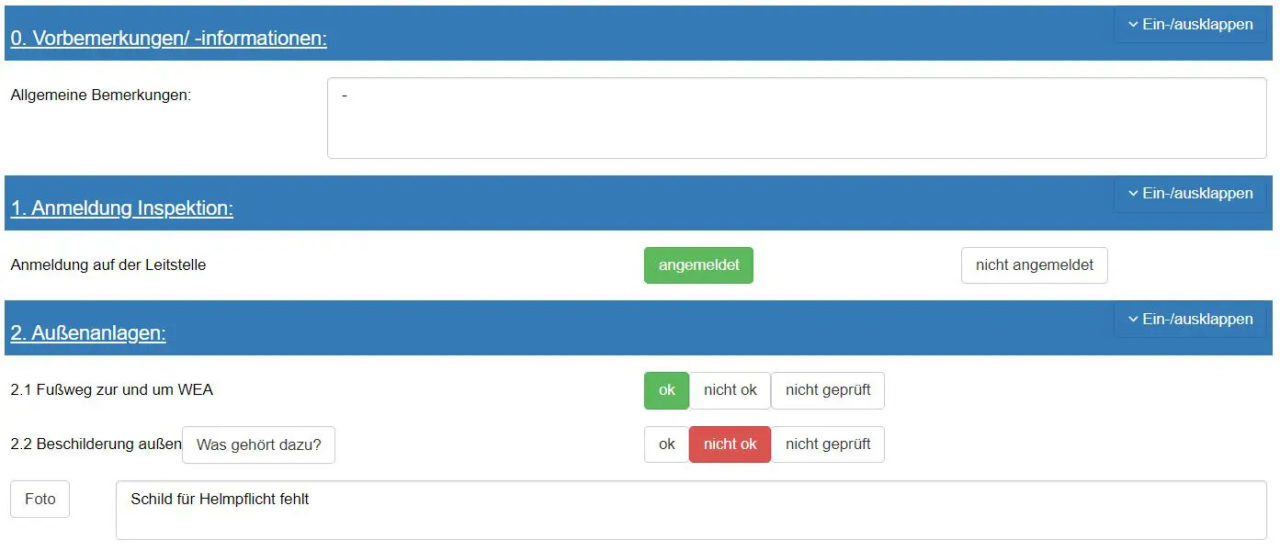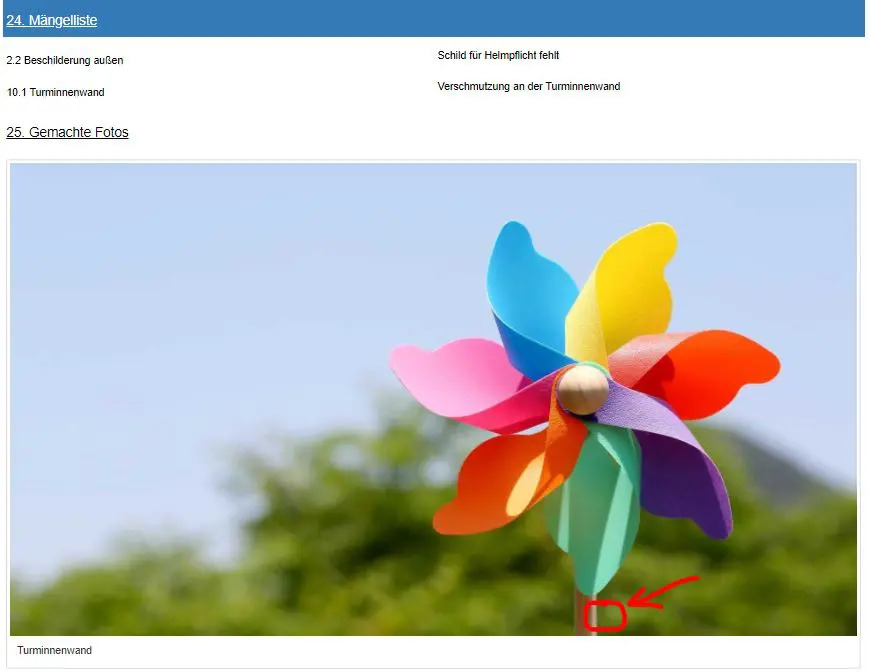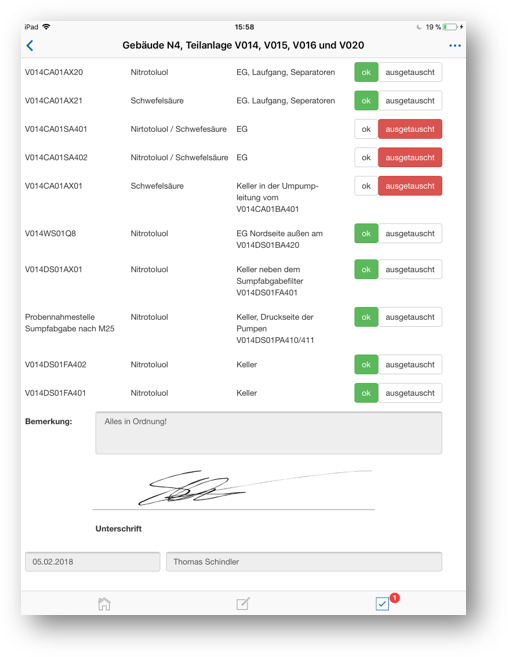Management and maintenance using the example of wind farms
The management of wind farms is very complex. On the one hand, there is the complete asset maintenance with master data management, parcel management, contract management with terms, deadlines and different shareholdings. On the other hand, there is the maintenance process for each individual wind turbine with defects and their rectification. In many places, this is still documented on paper, which ensures neither audit-proof archiving nor efficient forwarding of information.
Management of all asset information

A wide variety of information must be managed for a wind turbine:
- Information on the wind turbine such as company data, contact details of the manufacturer, shareholders, manuals, parts, maintenance cycles, location
- Information on the plot of land on which the wind turbine is located, dimensions and location, owner and lease agreements, sometimes with the involvement of different people
- Contracts for the use of the wind turbine with contractual partners and deadlines
Everything is documented in our software and if input options are missing, either the customer or we can add fields.
When a contract expires, for example, our software automatically reminds you by e-mail.

Complex maintenance process

We can support you throughout the entire maintenance process with our customizable forms and workflows. This starts with the registration at the control center with signature directly in the document, continues with all inspections at the wind turbine and ends with the subsequent logout at the control center. In addition, all inspection points are stored in our solution in an audit-proof manner. If certain points are marked as being out of order, a photo of the problem can be taken directly on site. The problem is then used as a ticket in our system or, for example, an email with a list of defects is sent. The problem-solving process is also documented using checklists so that you always have a history of problems that have occurred and how they were resolved. In addition, it is always possible to see which defects still exist in which wind turbines.
A particularly practical feature for our customers is that many changes to the inspection report can be made without any programming knowledge using our simple drag-and-drop Checkware Designer.

Management of wind farms:
Clear list of defects
All documented defects can be clearly displayed at the end of the checklist, and the documented photos can also be displayed here.
- Processing via “app”, even offline
- Forwarding of defects, e.g. by email or as an additional task in our system
- Storage of the inspection report directly on the asset
Synoset with notification and requirement management
- Status of all conditions and notifications at a glance
- Attachment of documents, links and comments to operating objects (“Digital Twin”)
- Mapping of all inspection processes, i.e. single inspections, cycles and random samples
- Derivation of activities to be carried out via tasks, checklists or tickets
- Verification and documentation of compliance with important requirements
- Integration of service providers if external support is required for inspections
- Audit-proof storage of all information with versioning
Get in touch!
Would you like to know more about our solutions? Then please write us using the contact form. My colleagues and I look forward to exchanging ideas with you.

Dominik Weggler
Head of Sales Germanedge
Customer use case: Wind energy
We can say a lot about ourselves and our software. However, no one can say more about our software than our customers, who use it every day.
Our user reports show how companies achieve success with our solutions. There is no better way to find out what our customers think!
Below is a customer use case from the wind energy sector. With more than 40,000 installed wind turbines, the company is one of the largest wind turbine manufacturers with several production sites worldwide.

Divisions
Each of the four product divisions is dedicated to the manufacture of a specific part of the wind turbine. There are aspects of quality management, such as data acquisition, that affect all divisions. However, there are also individual quality requirements that are only relevant to certain areas.
The nacelle consists of gears and bearings that are built around the main shaft and are driven by the rotor blades. Additional quality requirements here include the collection of torque data on all fasteners, SPC and traceability of components and materials.
The tower is the pillar, the base on which the nacelle is mounted. The recording and analysis of welding data, the documentation of material assemblies and traceability are the top priorities here.


Rotor blades. Each wind turbine requires three rotor blades, which are made of carbon fiber and glass to save weight. Depending on the type of wind turbine, the rotor blades are available in different lengths. The quality focus in the production of the rotor blades is on controlling the weight of each rotor blade and maintaining the exact shape for perfect aerodynamics. The elimination of faults and defects is essential, as the scrapping of a faulty rotor blade is associated with high costs.
Control systems. These are the hardware and software that control the wind turbine. The focus here is on achieving yield targets for the initial samples, supplier management and the tracking of parts and defects.

Global standardization of data collection
Given the size of the company, the complexity of the quality requirements and the global distribution of production sites, reconciling data and reports generated in different plants and by different suppliers is a major challenge. Millions of measurements are taken and analyzed every day.
Our QM software is installed on the central server. This is where all the data is recorded, stored and managed. The software standardizes all quality data. It ensures that measurements of the same characteristic are taken and analyzed in the same way everywhere. Consistent quality management begins with data acquisition. Even here, it must be ensured that all data is valid before it is imported and further processed. This guarantees the comparability of all data from every system and every machine worldwide.

Implementation and quality integration
The first step in introducing a new product or solution to a wind turbine manufacturer is a successful pilot installation. The pilot installation for QMS took place at the company’s headquarters in 2008 and included the QMS SPC software. Data was to be imported from over 500 devices and from various databases. In addition to the company’s own equipment, this also included welding machines, Zeiss coordinate measuring machines and special machines and test equipment for the wind energy sector.
QMS is implemented throughout the entire product life cycle chain, including the planning and approval process for newly developed parts and suppliers across the entire production chain with more than 5,000 employees working in the system around the clock. No part leaves production without being approved in QMS.


The manufacturer utilizes the possibilities of QM for use in:
- Quality planning – APQP4Wind including process flow, inspection plan, FMEA, PPAP and MSA.
- Incoming goods – quality assurance and release of incoming goods, including inspection and documentation, directly integrated with ERP.
- Data collection – Inspection planning to visualize characteristics, provide work instructions and support inspections directly integrated with MES.
- Data analysis & reporting – Visualization and partial acceptance via automated analysis & reporting using statistical methods directly integrated with KPI reporting.
- Complaint Management – Automated integration between data collection and defect resolution has significantly reduced the time required to manage the 8D process

ERP integration
QMS is integrated into the company’s existing SAP system and thus automatically receives further information, such as parts data, supplier master data, information on incoming goods orders or returns. This exchange takes place in both directions and also in exchange with warehouse management.
The MES connection
QMS is also integrated into the company’s existing MES system and also receives its information from here. It automatically receives production orders and recorded values from the MES system and returns relevant quality data to the MES system.
The synergies
QMS ensures that all quality data, from product planning to continuous improvement, is managed in an integrated system. This has created synergies over the years and significantly reduced quality costs. All recorded data, whether from the design phase or production, is error-proof and valid from the outset. It pays off across the entire line when reliable data is recorded. The integrated quality management system can thus get the best out of the data. In addition to the use of quality data analyses, the data can be passed on to suppliers and customers as documentation or product certificates. This forms the basis for quality planning, compliance and inspection, the use of complaint management software, and continuous improvement.
The automated analysis and reporting functions are located along the entire quality value chain and can therefore uncover problems in real time. The graphically supported reports are clear and easy to read and provide the right people with meaningful information to make robust decisions in a timely manner.
Customer focus

The company’s success depends on the successful installation and operation of the wind turbines at its customers. The wind turbine manufacturer takes on an active advisory role when working with its customers in order to develop the special requirements of its customers together with them and to support them with its specialist knowledge throughout the planning phase. The QMS-based quality assurance system is an essential part of the production process.
The software applies demand-oriented production resources for quality control at every process step, defines strict and precise takt times, utilizes SPC with Six Sigma objectives, establishes employee certification processes, and standardizes gauge and equipment management through integrated calibration management software.

Customer-specific analysis

The Quality Domain has developed a process in which work instructions run automatically. The QMS software itself assesses whether the production line is within the quality tolerances and the specified sigma level. QMS analyzes the output of certain processes to determine whether they are being carried out optimally or whether the very time-critical inspection and data acquisition processes need to be adjusted. Another customer-specific module was implemented to obtain automatic test certificates from QMS and to provide test evaluations using the QMS Report Designer.

Gondel Baugruppe
The entire nacelle assembly process is mapped in a single QMS inspection plan, with each step defined as a process. The inspection plan, which includes “order” fields and sample information, requires that each individual step must be completed with an “OK” before the next step can start. It also ensures that each component is traceable. These inspection plans contain up to 450 processes and cover several hundred characteristics.
Today, all information from production flows into the QMS database to ensure that documentation and work instructions are up to date. Once a nacelle has been assembled, including the correct cable attachment, the recorded data is imported using the QMS Import Manager. If QMS determines that the inspection results are OK, it summarizes the results in the corresponding reports. The software then automatically creates and distributes the inspection reports. The process generates millions of records that are stored in QMS. Therefore, QMS is able to log test results, identify defects, track rework and calculate the values that go into KPIs to enable meaningful comparisons.
With QMS at the core of its quality management platform, the company has introduced what all leading manufacturers are trying to achieve – an exemplary integrated quality system that continuously improves quality on multiple levels, reduces costs on a large scale and ensures your product performance worldwide.
Get in touch!
Would you like to know more about our solutions? Then please write us using the contact form. My colleagues and I look forward to exchanging ideas with you.

Dominik Weggler
Head of Sales Germanedge





